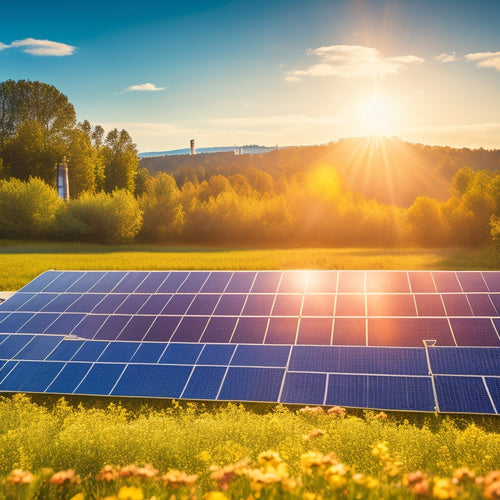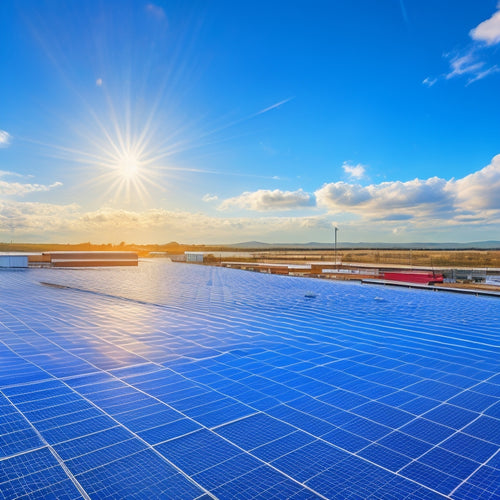
Green Energy Storage in a Renewable Future
Share
Green energy storage is essential for maximizing the potential of renewable energy. Advanced technologies like solid state and flow batteries enhance efficiency, allowing you to cut energy costs by up to 50%. These systems not only provide consistent power but also improve grid stability by managing supply fluctuations. Hydrogen storage offers long-term energy density benefits, enabling storage and dispatch of excess renewable power. By investing in these technologies, you promote sustainability and energy independence. Their impressive durability surpasses conventional battery systems, paving the path for a resilient energy future. To understand the implications of these innovations, investigate further perspectives on this topic.
At a Glance
- Advanced battery technologies like solid state and flow batteries improve energy efficiency and sustainability in renewable energy storage.
- Hydrogen energy storage offers high energy density and longer storage durations, enabling effective use of renewable energy resources.
- Home battery storage solutions can significantly reduce energy bills by storing excess renewable energy for later use.
- Energy storage systems enhance grid stability, ensuring consistent power supply and reducing reliance on fossil fuels.
- Innovations in energy storage technologies lead to long-term cost savings and promote a sustainable energy ecosystem.
Sustainable and Efficient Solutions
To achieve sustainable energy storage, you need to take into account advanced battery technologies and hydrogen energy storage systems.
Recent studies show that these solutions can greatly enhance energy efficiency and reduce reliance on fossil fuels.
Solar battery storage, for instance, captures excess energy from solar panels, allowing for efficient daily energy management and optimizing energy usage.
Advanced Battery Technologies
How can advanced battery technologies change our approach to energy storage? By capitalizing on innovations like solid state batteries and flow batteries, you can greatly enhance efficiency and sustainability in energy systems. Solid state batteries offer higher energy density and improved safety compared to traditional lithium-ion batteries, while flow batteries provide scalability and longer cycle life, making them ideal for large-scale applications.
Here's a quick comparison of these technologies:
| Battery Type | Advantages |
|---|---|
| Solid State Batteries | Higher energy density, enhanced safety |
| Flow Batteries | Scalability, longer cycle life |
Implementing these technologies can reshape your energy environment. For instance, solid state batteries can revolutionize electric vehicles by providing longer ranges and faster charging times. Meanwhile, flow batteries can enable renewable energy sources, like wind and solar, to be stored and dispatched more effectively, ensuring reliability in power supply.
As you investigate these technologies, consider the potential they hold to enable a more sustainable energy system, giving you greater freedom and flexibility in how you leverage and apply energy.
Hydrogen Energy Storage
As advanced battery technologies pave the way for more efficient energy systems, hydrogen energy storage emerges as an enticing alternative that employs the unique properties of hydrogen to store excess energy. This method exploits hydrogen production, which can occur through various processes, including electrolysis powered by renewable sources. By splitting water into hydrogen and oxygen, you can create a clean fuel that's easy to store and transport.
The stored hydrogen can then be applied in fuel cells to generate electricity when demand peaks. Unlike conventional batteries, hydrogen systems exhibit a higher energy density and longer storage durations, making them ideal for balancing intermittent renewable energy sources such as wind and solar. Studies indicate that hydrogen can achieve efficiencies of up to 70% when converted back to electricity through fuel cells.
Moreover, hydrogen's versatility extends beyond energy storage; it can also power vehicles and industrial processes. As you adopt hydrogen energy storage, you're not just embracing an innovative technology; you're contributing to a sustainable energy ecosystem that promotes energy independence and reduces reliance on fossil fuels.
This could be the key to a truly renewable future, giving you the freedom to tap into energy in smarter ways.
Cost Savings Over Time
When you invest in green energy storage systems, you're not just making an environmentally friendly choice; you're also positioning yourself for significant long-term savings.
Home battery storage enhances energy independence by allowing you to store excess renewable energy for later use, ultimately leading to reduced energy bills.
Data shows that these systems can reduce your energy bills by up to 50%, depending on usage patterns and local energy costs.
Over time, the initial investment pays off, enhancing both your financial stability and energy independence, while contributing to a more sustainable lifestyle through renewable energy integration.
Long-term Investment Benefits
Considering the rising costs of traditional energy sources, investing in green energy storage systems offers significant long-term benefits, particularly in cost savings. By committing to green investments now, you position yourself to utilize future innovations in technology that enhance energy efficiency and storage capacity.
Data shows that the initial investment in such systems can lead to a reduction in reliance on fossil fuels, translating into substantial savings over time. For instance, integrating advanced battery systems can lower operational costs by up to 30% compared to conventional energy methods. These savings accumulate, as the lifespan of modern energy storage solutions often exceeds two decades.
Additionally, as the market for renewable energy grows, the cost of storage technologies is projected to decline, further increasing your return on investment.
Moreover, investing in green energy storage not only mitigates volatility in energy prices but also enhances your energy independence. You gain the freedom to control your energy consumption and costs, insulating yourself from fluctuating market conditions.
Essentially, the long-term benefits of investing in green energy storage systems extend beyond immediate savings, providing a sustainable path toward financial and environmental resilience.
Reduced Energy Bills
Investing in green energy storage systems directly translates into reduced energy bills over time. By utilizing renewable energy sources and implementing energy conservation strategies, you can achieve significant savings.
With utility incentives often available for adopting sustainable practices, your initial investment becomes even more feasible.
Integrating smart appliances into your energy management strategy enhances this effect, allowing you to optimize energy usage. During peak demand periods, you can employ peak shaving techniques, storing energy when rates are low and discharging it when prices soar. This not only cuts costs but also supports demand response initiatives, easing stress on the grid.
Effective grid integration guarantees that your energy systems work in harmony with the existing infrastructure, maximizing efficiency. Additionally, renewable incentives can further lower expenses, making green energy storage not just an eco-friendly choice but also a financially sound one.
In the long run, incorporating these practices into your financial planning can lead to a stable, predictable energy expenditure. As you adopt these technologies, you not only take control of your energy costs but also contribute to a more sustainable future.
Your freedom from fluctuating energy prices starts here.
Key Advantages of Storage Systems
When considering storage systems, you'll find that enhanced energy reliability is a vital advantage, ensuring consistent power availability regardless of production fluctuations.
This reliability is particularly essential in off-grid situations, where systems like deep cycle batteries are designed for frequent charge and discharge cycles.
Additionally, these systems often present cost-effective solutions by optimizing energy use and reducing peak demand charges.
Enhanced Energy Reliability
Energy storage systems considerably enhance reliability by providing a buffer against fluctuations in energy supply and demand. These systems play an essential role in ensuring grid stability, especially as you shift towards greener energy sources.
With intermittent renewables like solar and wind, energy production can be unpredictable. Storage systems, such as batteries and pumped hydro, capture excess energy when generation outpaces demand, allowing you to draw on this stored energy when supply dips.
Data shows that implementing energy storage can reduce the need for fossil fuel backup generation by up to 50%, directly supporting the energy shift. Additionally, these systems can respond instantaneously to grid disturbances, maintaining frequency and voltage levels, which is critical for preventing outages.
The increased reliability not only enhances the user experience but also enables you with the freedom to employ renewable energy without fear of inconsistency.
As you invest in advanced storage technologies, you're not just supporting your own energy needs; you're contributing to a more resilient, sustainable energy environment.
This change not only benefits individual users but also fortifies the entire grid, laying the groundwork for a more sustainable future.
Cost-Effective Solutions
Cost-effective energy storage solutions offer significant financial advantages for both consumers and utilities. By utilizing solar energy during peak production times and storing it for later use, you can reduce reliance on costly fossil fuels and enhance grid integration.
This shift is reinforced by favorable policy incentives that encourage investment in storage technologies, driving down costs through economies of scale.
As market trends shift towards renewable energy, you'll notice an increase in demand response programs, allowing you to manage energy consumption more effectively.
Technological innovation is key in developing advanced battery systems that not only lower environmental impact but also support recycling programs for end-of-life materials.
Regulatory structures play an essential role in promoting community engagement, encouraging local initiatives that enable citizens to participate in sustainable energy practices.
By adopting these solutions, you're not just saving money; you're contributing to a greener future while reaping the benefits of energy independence.
The collaboration between cost-effective storage and renewable energy paves the way for a resilient energy environment, ensuring you can adapt to changing energy needs without compromising on freedom or sustainability.
Assessing Capacity and Efficiency
When evaluating energy storage technologies, you need to take into account both their capacity and efficiency metrics.
Capacity refers to the amount of energy a system can store, while efficiency measures how effectively that stored energy can be retrieved and used.
Energy storage cost optimization is also essential, as it directly impacts the feasibility and long-term viability of the storage solutions you choose.
Energy Storage Technologies
Evaluating capacity and efficiency in energy storage technologies is essential for optimizing renewable energy systems. You need to understand how different technologies impact grid integration and energy resilience.
Battery storage, pumped hydro, and innovative methods like compressed air energy storage each demonstrate unique capabilities in demand response and scalability.
Technological advancements continue to shape market trends, allowing for more effective storage solutions customized to specific energy needs. By conducting lifecycle analysis, you can assess the environmental impact of various storage options, factoring in manufacturing, operation, and disposal stages.
Policy incentives play a critical role as well, encouraging investment in more efficient storage technologies that promote renewable collaboration. As you investigate these options, consider how scaling up storage solutions can enhance the overall efficiency of renewable energy systems.
Ultimately, the right energy storage technology not only supports your energy goals but also contributes to a sustainable future. By focusing on capacity, efficiency, and environmental considerations, you can make informed decisions that align with both economic and ecological objectives.
Efficiency Metrics Evaluation
In evaluating energy storage efficiency metrics, it's vital to take into account various factors that directly impact performance. You need to focus on performance benchmarks, which provide a standard for comparing different storage technologies. These benchmarks often include round-trip efficiency, discharge time, and energy density. By analyzing these metrics, you can identify areas for efficiency improvements.
Consider the round-trip efficiency, which indicates how much energy is retained after storage and retrieval processes. A higher round-trip efficiency translates to less energy wasted, making the system more effective.
It's also important to evaluate energy density, as it affects how much energy can be stored in a given volume or weight. Systems with high energy density are more desirable, especially in applications where space is limited.
Furthermore, regularly evaluating these metrics allows you to benchmark against industry standards, enabling you to track advancements and make informed decisions about technology adoption.
Longer Lifespan Than Batteries
When considering energy storage solutions, you'll find that options like supercapacitors and flywheels offer enhanced durability and reliability compared to traditional batteries.
Research indicates these technologies can withstand thousands of charge-discharge cycles without notable degradation, extending their operational lifespan markedly.
This longevity not only reduces replacement costs but also minimizes environmental impact, making them an attractive choice for sustainable energy systems.
Enhanced Durability and Reliability
Advanced energy storage systems exhibit enhanced durability and reliability, noticeably outpacing traditional batteries in lifespan. Research indicates that next-generation systems, such as flow batteries and solid-state technologies, can endure over 10,000 charge cycles compared to the 2,000-3,000 cycles typical of lithium-ion batteries.
This longevity translates to considerably lower replacement costs and reduced environmental impact, as fewer batteries are discarded.
Material innovation plays a crucial part in this advancement. New components, like advanced electrolytes and durable casing materials, improve resilience against extreme temperatures and physical stress.
These innovations not only extend operational life but also enhance performance consistency under varying conditions, ensuring you've reliable energy when you need it.
Additionally, the reduced need for frequent replacements minimizes the ecological footprint associated with battery production and disposal. By investing in these sturdy storage solutions, you're not just enhancing your energy independence; you're also contributing to a more sustainable future.
With enhanced durability and reliability, these systems enable you to utilize renewable energy efficiently, ensuring that your energy solutions align with your desire for freedom and sustainability.
Frequently Asked Questions
What Are the Environmental Impacts of Energy Storage Systems?
You'll find energy storage systems impact the environment through their carbon footprint, resource extraction, and land use. Conducting lifecycle analysis and planning for end-of-life disposal is essential to maintain ecological balance and minimize adverse effects.
How Do Different Storage Technologies Compare in Terms of Safety?
When it comes to storage technologies, think of safety as a tightrope walk. Battery safety hinges on thermal stability, chemical hazards, and leak prevention. Each technology varies considerably, influencing risk management and operational reliability.
What Regulatory Challenges Affect Energy Storage Development?
You'll find regulatory challenges considerably hinder energy storage development. Complicated permitting processes, inconsistent safety standards, market barriers, interconnection issues, and inadequate incentive programs all impact performance metrics, limiting your ability to innovate and deploy effective solutions.
Can Energy Storage Systems Be Integrated With Smart Grids?
"Where there's a will, there's a way." You can integrate energy storage systems with smart grids to enhance grid optimization, improve demand response, enable renewable integration, elevate storage efficiency, and effectively manage peak shaving for energy management.
What Role Do Consumers Play in Energy Storage Adoption?
Consumers drive energy storage adoption by increasing awareness and leveraging financial incentives. When you understand the benefits and savings potential, you're more likely to invest in storage solutions that enhance your energy independence and sustainability.
Explore More
In a world where renewable energy sources are projected to supply 70% of global electricity by 2040, effective energy storage becomes essential. With advanced storage systems capable of holding energy for hours, you're looking at a potential reduction in reliance on fossil fuels by up to 80%. This shift not only secures a more sustainable future but also affirms cost efficiency and longevity, making energy storage a key player in the shift to green energy.
Related Posts
-

Advantages of Solar Generating Systems Over Traditional Energy
Solar generating systems provide several key advantages over traditional energy sources. You'll experience lower long...
-

Top Camping Water Bottles for Adventure
When you're out adventuring, picking the right camping water bottle is essential for staying hydrated. Look for durab...
-

Commercial Solar Energy
As you consider powering your business with commercial solar energy, you'll uncover it offers a triple benefit: signi...


